fun with extrapolations
We’re off the shores of offseason and wading toward the Signing Day drop-off, and 247 recently released their final 2018 rankings, so I thought now would be a good time to update my big, useful roster database.
apologies for giving Rutgers a competitive advantage
It can tell you fun things, like how this year’s recruiting class stacks up against previous ones:
(it’s like the 2014 one, ratings-wise)
…or the NFL outcome of Michigan recruits by their relative star ratings:
| As Recruit | Players | Rnds 1-3 | Rnds 4-7 | UDFA+ | UDFA | No NFL |
|---|---|---|---|---|---|---|
| ☆☆☆☆☆ | 17 | 9 (53%) | 2 (12%) | 1 (6%) | 2 (12%) | 3 (18%) |
| ☆☆☆☆½ | 64 | 9 (14%) | 12 (19%) | 3 (5%) | 9 (14%) | 31 (48%) |
| ☆☆☆☆ | 110 | 17 (15%) | 16 (15%) | - | 1 (1%) | 76 (69%) |
| ☆☆☆½ | 85 | 2 (2%) | 7 (8%) | - | 1 (1%) | 75 (88%) |
| ☆☆☆ | 113 | 4 (4%) | 7 (6%) | 1 (1%) | - | 101 (89%) |
| ☆☆ | 14 | - | - | 1 (7%) | - | 13 (93%) |
| Walk-on | 26 | 1 (4%) | 1 (4%) | - | - | 24 (92%) |
Or how attrition is going:
(it has stayed relatively low compared to Rodriguez and Carr)
(few players are leaving without degrees)
If you download and play around a bit you can quickly find things like which players each recruiting service adored/didn’t think much of relative to each other:
| Rivals | Scout | ESPN | 247 | |
|---|---|---|---|---|
| Loved
| Steve Breaston | Paul Sarantos | Marques Walton | Benjamin St-Juste |
| Conelius Jones | Austin White | Rueben Riley | Cameron McGrone | |
| Kevin Koger | Andrew Stueber | Junior Hemingway | Nate Johnson | |
| Jeremy Gallon | De'Veon Smith | Ja'Raymond Hall | Oliver Martin | |
| Alex Mitchell | Patrick Omameh | Isaiah Bell | Jaylen Mayfield | |
| Hated
| Ja'Raymond Hall | Kingston Davis | Kevin Koger | Austin White |
| Andrew Stueber | Alex Mitchell | Brandon Smith | Conelius Jones | |
| Brandon Watson | Keith Washington | Dennis Norfleet | Brad Robbins | |
| Paul Sarantos | Gabe Watson | Boubacar Cissoko | Myles Sims | |
| Ronnie Bell | Reuben Jones | Rocko Khoury | Zach Gentry |
--------------------------------
Direct Recruiting Comparisons
There’s also a second table that shows all of the recruiting data that went into my composite rankings, if you want to quickly compare where the sites put Luke Schoonmaker to Sean McKeon (they’re nearly identical):
…or place Cam McGrone among Michigan’s all-time linebacker recruits:
…or settle an argument with the guy who said Mike Hart was “just a three-star”:
(he was only barely)
…or just pull up a quick list of who’s eligible for this year’s NFL draft. I mostly use it to put the new recruits in context. Like it’s good to know Christian Turner is basically tied with Chris Evans, that Aidan Hutchinson ended up almost exactly where Ryan Van Bergen was rated, and that Jarrod Wilson and Gemon Green wound up right where Benjamin St-Juste did (German Green is down in the JT Floyd/Courtney Avery/James Rogers region). Seeing a handful of former players whose careers (and ceilings) I’m familiar with is more helpful to placing a croot than where he stands among the thousands of high schoolers of his own year whom I haven’t seen.
--------------------------------
Starter Data
Lastly I updated the starter data with 2017 starts, which by the way featured a lot of stuff like three tight ends or three fullbacks. Those atypical start formations are more helpful than hurtful—it’s accurate to say that Gentry and McKeon were more active in the passing game, for example, than Eddie McDoom or Nate Schoenle.
You may remember last year was a crazy low bar for starts returning. Things are getting back to normal. Rather than a historically green team Michigan will have a slightly below averagely experienced team:
The big difference you can’t see here is the distribution of OL starts: last year almost all of the returning OL experience was concentrated in one guy; this year it’s spread out among six dudes: Bredeson, Ruiz, Onwenu, JBB, Ulizio, and Runyan.
The last bit highlights a flaw in reading returning starts without context: there aren’t many years in trackable Michigan history in which any of those guys would have gotten extensive playing time. It also hides regular contributors who didn’t technically start—2016 Maurice Hurst being the case example.
Digging down to game-by-game start data gives us a clearer, albeit imperfect, sample of what was on the field. And last year—to the surprise of nobody—it was historically young.
Let’s put those bars in context: the average starter for Michigan last year on both units was younger than a redshirt sophomore. Only twice in the last 20 years did any one unit dip below that mark: the 2008 offense, and the 2009 defense. I’m sure I don’t have to remind you how that went.
The bad news here is the offense at least is in for another year of historical youngness, quite likely falling below even this year. I plugged the following projection of 2018 starts: Patterson (13), Evans (6), Higdon (7), Mason (8), McKeon (11), Wheatley (2), Gentry (7), Eubanks (1), Black (10), DPJ (8), Crawford (1), and an OL of Newsome-Bredeson-Ruiz-Onwenu-Hudson, and it came out at an average year in program of 2.67, barely above 2008.
Does it matter? With the exception of 1997, the peak years do seem to correlate to the teams playing the guys who’ve been around awhile: 1999, 2002, 2003, 2006, 2011, 2012, and 2016. On the other hand Ohio State managed to put up a strong offense in 2016 despite a similarly young roster, though it should be noted they were operating under an experience QB and the young players were holes that got exploited by better teams.
(I never know what to do here with transfers who’ve started at previous stops. Considering the performance of said transfers when they have played, the most accurate thing to do is to just throw that data out—after all they’re new to the system.)
The other interesting thing I can do with starter data is to check personnel shifts. In the past I used it to show the relative mass on the field between coaches. But the Harbaughification of the offense is clear in other ways, like starting more tight ends:
| AVG Skill Position Personnel at First Snap | ||||
|---|---|---|---|---|
| Season(s) | RBs | FBs | TEs | WRs |
| Carr | 0.99 | 0.62 | 1.27 | 2.11 |
| Rodriguez | 1.22 | 0.14 | 0.78 | 2.86 |
| Hoke | 0.98 | 0.45 | 1.12 | 2.45 |
| 2015 | 1.02 | 0.94 | 1.09 | 1.95 |
| 2016 | 1.00 | 0.69 | 1.77 | 1.54 |
| 2017 | 0.92 | 0.77 | 1.92 | 1.38 |
Anyway if you want to download your own copy of my data and play with it, you’re welcome to it. Just share your findings in the diaries.
Long. Splitting into halves.
It's a trend: Michigan spring games have returned to their sleepy past, meaning little and failing to reveal Savior Quarterback Who Will Save Us. This is a good thing, since the titanic importance of spring games under Rodriguez was symptomatic of a program drunkenly staggering from one rickety support to another.
It would be nice if Michigan could put together an actual game like you see at OSU, ND, and many SEC schools. Maybe next year.
Anyway, highlights to remind you of some of the things chattered about below:
Bionic Men
The most important thing that happened yesterday was Hoke muttering something about Jake Ryan's return timeframe:
"I'm not a doctor, but possibly middle of October. Some people react differently."
That would be excellent. The critical bit of Michigan's schedule is… well, all of November, when they play State, Nebraska, Northwestern, Iowa and OSU, ie: the top half of their division, Iowa, and The Game. The only games before November that look competitive are against Notre Dame and Penn State, and Penn State should start dropping off what with their sanctions.
Ryan may even be back for that one, which is on the 12th. Indiana and a bye week follow, so Ryan may not just be back by the important bits of the schedule but established. As far as devastating season-ending ACL injuries to your best player on defense go, I like this one more than I expected I would.
Meanwhile, Blake Countess and Fitzgerald Toussaint both warmed up like nothing untoward had happened to them. (Neither was taking contact.) Countess's injury is far enough in the past that it's reasonable to expect that. Seeing Toussaint out there was a moment of shock for me. He didn't take any contact but if he's out there running five months before the season he will certainly be available in fall, which is when those soccer players who had the same injury came back anyway.
Devin Gardner Looked Good
![8645421821_87aab64dc7_z[1] 8645421821_87aab64dc7_z[1]](https://mgoblog.com/sites/mgoblog.com/files/images/Spring_93A9/8645421821_87aab64dc7_z1.jpg)
this picture feels goooood (Eric Upchurch)
If Denard Robinson hadn't gotten hurt, this would have in fact been a Big Deal, as Gardner would be an heir apparent with no track record except his performance in the three previous spring games: awful, awful, and awful. With five starts dwarfing all spring data in importance, it's not a big deal. It is nice. Precisely nice.
In this one he did throw his traditional pick six to a linebacker he doesn't see coming underneath a receiver (Desmond Morgan dropped this one); aside from that he was 11 of 15 for about 140 yards, picking up where he left off in the fall. That's a very large jump from last year, when Gardner's performance had everyone buzzing about how Russell Bellomy looked like a plausible backup and let's just move Gardner to wide receiver already.
Here's the part you'll see about six more times before the opener about how if you extrapolate Gardner's statistics out to a full season you get some crazy numbers: 60% completion percentage, 9.7 YPA, 29:13 TD:INT, and nearly 3200 yards passing. That would be a Michigan record for TDs and brush up against John Navarre's 2003 season for yards. It would also vie for the best YPA season in the era when offenses throw the ball more than ten times a game—Jim Harbaugh hit 9.9 in 1986*.
Those numbers are a touch flattering since they include the bail-out against Northwestern and a couple of long touchdowns generated more by the defense screwing up than Gardner doing anything amazing—thinking primarily of Roundtree against OSU here. But then again we're talking about a guy who had been playing most receiver before being thrust into the starting job against Minnesota and a statline assembled against a set of defenses that were collectively pretty good. Pass efficiency Ds for the five Gardner opponents: 23rd (Minnesota), 33rd (Northwestern), 75th (Iowa), 29th (OSU), and 34th (South Carolina). At most one of those is a flailing patsy, and even the dismal Iowa defense was a far cry from MAC snacks not named Central Michigan.
Anyway: Gardner's calm demeanor and accuracy is another chunk of evidence to put on the pile. Maybe a small one, sure.
*[Rick Leach had a whopping 11 YPA in 1979, but only threw the ball 130 times. Yes, he only threw 130 times when he had Anthony Carter as an option. Football has changed.]
Running Backs: Wait Until Fall
With Fitzgerald Toussaint now certainly on the list of running backs not participating on Saturday who will be major threats for playing time, any conclusions drawn here are likely to be about the guy getting two carries a game behind Fitz and Derrick Green or DeVeon Smith. But it is spring, when we display our most colorful obsessions in an attempt to win mates. Let us proceed.
Going by the substitution patterns it seemed like Justice Hayes was tentatively your starter. He took advantage of this situation to average 0.5 YPC on two carries. Drake Johnson picked up less than a YPC himself, leaving Thomas Rawls and Dennis Norfleet to pick up the only real gains of the day by a tailback.
Both of those backs were going up against primarily backups. Usefulness: not assured. I mean, in one of the longish Rawls runs above he breaks a tackle from Terry Richardson, who's still about a buck fifty soaking wet. In the other a walk-on SAM gets crushed inside and the corner is open for days.
![8645438847_7abef1c97f_z[1] 8645438847_7abef1c97f_z[1]](https://mgoblog.com/sites/mgoblog.com/files/images/Spring_93A9/8645438847_7abef1c97f_z1.jpg)
It will surprise no one that I thought Norfleet looked good. In the run featured at 2:10 in the highlight video he's behind mostly walk-ons and facing mostly starters. Black beats up Blake Bars and forces Norfleet away from blocking. Norfleet slips behind that block so fast that RJS has no shot at him, then he jukes Jeremy Clark out of his jock—and this is important for any coach but especially one Brady Hoke—to go north-south. On his other quality run (sadly not included in the highlights) he did the same thing: threaten outside so he could cut north-south and finish his run.
(@ right: Upchurch)
They did include the blown up zone stretch, and on that one you can see he just doesn't have a chance as Keith Heitzman rips through a block and forces Norfleet outside into Cam Gordon. He probably should have just eaten a two yard loss instead of testing Gordon.
Here's the thing though: Michigan didn't show a snap of pistol or much of anything, really. You know Al Borges loves his throwback screens, especially when he's got a guy as mobile as Gardner threatening the other side of the field. Who do you want grabbing those? Obviously Norfleet. Okay maybe Hayes, but we haven't really seen anything from him in that regard yet. Whoever gets that role has got to be plausible enough as an inside runner and blocker to not be a flashing throwback screen signal. I think we saw a couple things from Norfleet that bode well in that regard.
It's harder to get excited about Rawls given what we saw from him last season. Norfleet has the advantage of being a new toy, at least when it comes to getting carries in the backfield.
Receivers: Are They Supposed To Be A Problem?
Jeremy Gallon is going to catch a billion passes this fall, lots of them hitches, some of them hitch and go, some of them comeback screens. It's not so much the frequency with which Gardner targeted him on Saturday that makes me say this but the ease of the connection. When Gardner's throwing at Gallon it just seems easy.
Gallon reminds me of that moment after Braylon's departure when Michigan tried to establish Breaston as a deep threat. This was a rousing success until the moment Breaston had to bring in a ball over his head. IIRC he dropped it literally every time. But by God he was open.
Gallon is like that. His change of direction is elite, and Michigan is going to go hitch hitch hitch seeya this fall. By God, Gallon will be open. The difference: Gallon can actually catch downfield. His stature always makes him a tough target—see that corner route Gardner zinged well over his head—but we've seen him make a bunch of tough catches. Hell, he's even effective on fade routes in the endzone, a development that is still mindblowing even months afterwards.
Upshot: don't care if he's small, Gallon is a legit #1. Hell, he was fourth in the league in receiving yards last year despite operating in a Denard-centered offense for most of it. Let's have more Fun With Extrapolation: Gallon's hypothetical stats if Gardner was QB all year: 81 catches, 1330 yards.
Meanwhile, the guys surrounding Gallon will be fine. Drew Dileo didn't do much in the spring game but we've established who he is: a sure-handed slot guy who will find the foot of space he needs to convert on third and six. Devin Funchess should be a much bigger factor in year two. This is a proverbial weapon:
![8647603632_b83b01176a_z[1] 8647603632_b83b01176a_z[1]](https://mgoblog.com/sites/mgoblog.com/files/images/Spring_93A9/8647603632_b83b01176a_z1.jpg)
Bryan Fuller
Darboh looked good finding a 30-yard fade on the first play from scrimmage; Jeremy Jackson made some plays. They'll have 4-5 solid options to go with a great #1. As points for concern go, this one doesn't register with me.
As for the second-year guys, Darboh seems a bit ahead of Chesson; both will play. You can see why Chesson redshirted last year when you get him next to Darboh, as Bryan Fuller did:
![8647613580_3c8bf158fe_z[1] 8647613580_3c8bf158fe_z[1]](https://mgoblog.com/sites/mgoblog.com/files/images/Spring_93A9/8647613580_3c8bf158fe_z1.jpg)
Still a bit of a Caris LeVert vibe from Chesson. They might have to protect him against jams by having him off the line, that sort of thing. Darboh looks like that won't be a problem.
The Line
![8647593632_d60a4bc243_z[1] 8647593632_d60a4bc243_z[1]](https://mgoblog.com/sites/mgoblog.com/files/images/Spring_93A9/8647593632_d60a4bc243_z1.jpg)
Bryan Fuller
I can't tell you I noticed a lot of details live, but one thing did jump out: Graham Glasgow seems to be making a serious push for playing time. He got plenty of snaps with the ones at both guard spots and center. He was the nominal starter at left guard over Ben Braden; at the very least it seems like he'll be the first interior lineman off the bench in the event a starter is hurt. He's their utility infielder.
The rest of the line seems set, with Kyle Kalis taking a large majority of the first team RG snaps and Jack Miller the same number at center. It is vaguely possible the arrival of Patrick Kugler or emergence of someone down the depth chart upsets the order of things, but I think that's your interior line: Glasgow OR Braden, Miller, Kalis. Joey Burzynski seems to have dropped back from the group with serious playing time prospects. Chris Bryant was well down the depth chart but did get on the field some. He could emerge if the injury is still holding him back.
Performance was a mixed bag. Michigan seems to want to pull Kalis to Lewan on a lot of plays. Good in theory; not entirely executed in practice. For example, at 1:10 in the highlights above you get a replay of last year's MLB misidentification: Michigan wants to run power behind Lewan with Kalis pulling; Michigan blitzes the A-gaps; Miller doesn't read this and sets up to block nobody; an unblocked Ross meets Johnson in the backfield, with Morgan unblocked right behind. Braden got smoked by Black for a sack a bit later.
Michigan yanked Lewan relatively early. Michigan put Erik Magnuson out there, and he did just okay. Pass rush was a lot easier to get with Lewan out of there (surprise!). Given the push Braden is making at guard I bet that any Lewan injury—knock on wood—sees Schofield flip to LT with Braden moving to RT and Glasgow drawing in at guard, if he's not already on the field. Michigan prefers a best-five-guys approach over any specific positional backup.
Defense in a bit.
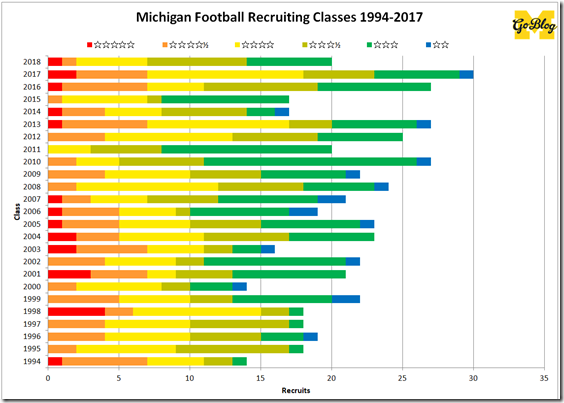

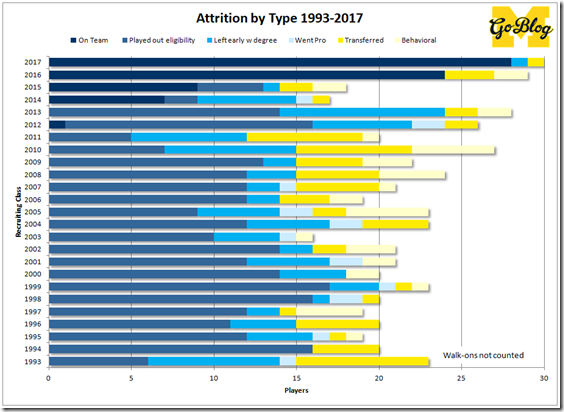



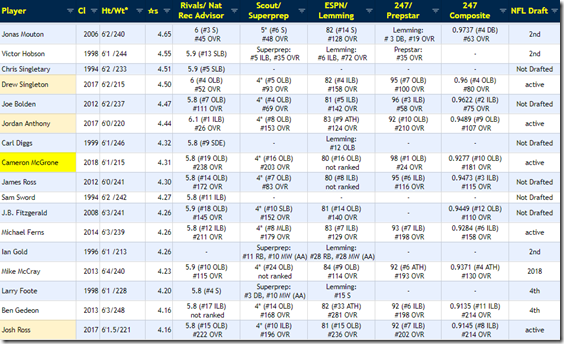

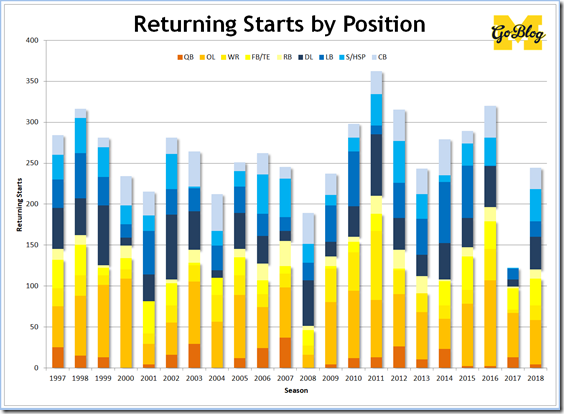

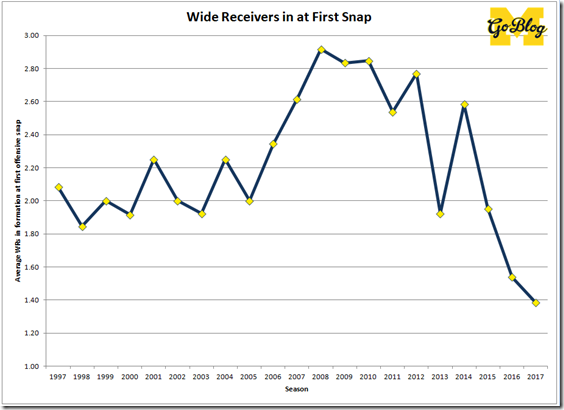
33